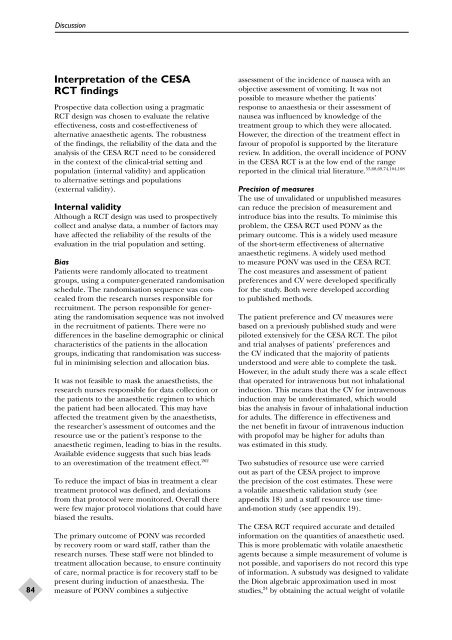Aanesthetic Agents for Day Surgery - NIHR Health Technology ...
Aanesthetic Agents for Day Surgery - NIHR Health Technology ...
Aanesthetic Agents for Day Surgery - NIHR Health Technology ...
Create successful ePaper yourself
Turn your PDF publications into a flip-book with our unique Google optimized e-Paper software.
84<br />
Discussion<br />
Interpretation of the CESA<br />
RCT findings<br />
Prospective data collection using a pragmatic<br />
RCT design was chosen to evaluate the relative<br />
effectiveness, costs and cost-effectiveness of<br />
alternative anaesthetic agents. The robustness<br />
of the findings, the reliability of the data and the<br />
analysis of the CESA RCT need to be considered<br />
in the context of the clinical-trial setting and<br />
population (internal validity) and application<br />
to alternative settings and populations<br />
(external validity).<br />
Internal validity<br />
Although a RCT design was used to prospectively<br />
collect and analyse data, a number of factors may<br />
have affected the reliability of the results of the<br />
evaluation in the trial population and setting.<br />
Bias<br />
Patients were randomly allocated to treatment<br />
groups, using a computer-generated randomisation<br />
schedule. The randomisation sequence was concealed<br />
from the research nurses responsible <strong>for</strong><br />
recruitment. The person responsible <strong>for</strong> generating<br />
the randomisation sequence was not involved<br />
in the recruitment of patients. There were no<br />
differences in the baseline demographic or clinical<br />
characteristics of the patients in the allocation<br />
groups, indicating that randomisation was successful<br />
in minimising selection and allocation bias.<br />
It was not feasible to mask the anaesthetists, the<br />
research nurses responsible <strong>for</strong> data collection or<br />
the patients to the anaesthetic regimen to which<br />
the patient had been allocated. This may have<br />
affected the treatment given by the anaesthetists,<br />
the researcher’s assessment of outcomes and the<br />
resource use or the patient’s response to the<br />
anaesthetic regimen, leading to bias in the results.<br />
Available evidence suggests that such bias leads<br />
to an overestimation of the treatment effect. 262<br />
To reduce the impact of bias in treatment a clear<br />
treatment protocol was defined, and deviations<br />
from that protocol were monitored. Overall there<br />
were few major protocol violations that could have<br />
biased the results.<br />
The primary outcome of PONV was recorded<br />
by recovery room or ward staff, rather than the<br />
research nurses. These staff were not blinded to<br />
treatment allocation because, to ensure continuity<br />
of care, normal practice is <strong>for</strong> recovery staff to be<br />
present during induction of anaesthesia. The<br />
measure of PONV combines a subjective<br />
assessment of the incidence of nausea with an<br />
objective assessment of vomiting. It was not<br />
possible to measure whether the patients’<br />
response to anaesthesia or their assessment of<br />
nausea was influenced by knowledge of the<br />
treatment group to which they were allocated.<br />
However, the direction of the treatment effect in<br />
favour of propofol is supported by the literature<br />
review. In addition, the overall incidence of PONV<br />
in the CESA RCT is at the low end of the range<br />
reported in the clinical trial literature. 53,68,69,74,104,108<br />
Precision of measures<br />
The use of unvalidated or unpublished measures<br />
can reduce the precision of measurement and<br />
introduce bias into the results. To minimise this<br />
problem, the CESA RCT used PONV as the<br />
primary outcome. This is a widely used measure<br />
of the short-term effectiveness of alternative<br />
anaesthetic regimens. A widely used method<br />
to measure PONV was used in the CESA RCT.<br />
The cost measures and assessment of patient<br />
preferences and CV were developed specifically<br />
<strong>for</strong> the study. Both were developed according<br />
to published methods.<br />
The patient preference and CV measures were<br />
based on a previously published study and were<br />
piloted extensively <strong>for</strong> the CESA RCT. The pilot<br />
and trial analyses of patients’ preferences and<br />
the CV indicated that the majority of patients<br />
understood and were able to complete the task.<br />
However, in the adult study there was a scale effect<br />
that operated <strong>for</strong> intravenous but not inhalational<br />
induction. This means that the CV <strong>for</strong> intravenous<br />
induction may be underestimated, which would<br />
bias the analysis in favour of inhalational induction<br />
<strong>for</strong> adults. The difference in effectiveness and<br />
the net benefit in favour of intravenous induction<br />
with propofol may be higher <strong>for</strong> adults than<br />
was estimated in this study.<br />
Two substudies of resource use were carried<br />
out as part of the CESA project to improve<br />
the precision of the cost estimates. These were<br />
a volatile anaesthetic validation study (see<br />
appendix 18) and a staff resource use timeand-motion<br />
study (see appendix 19).<br />
The CESA RCT required accurate and detailed<br />
in<strong>for</strong>mation on the quantities of anaesthetic used.<br />
This is more problematic with volatile anaesthetic<br />
agents because a simple measurement of volume is<br />
not possible, and vaporisers do not record this type<br />
of in<strong>for</strong>mation. A substudy was designed to validate<br />
the Dion algebraic approximation used in most<br />
studies, 24 by obtaining the actual weight of volatile
















